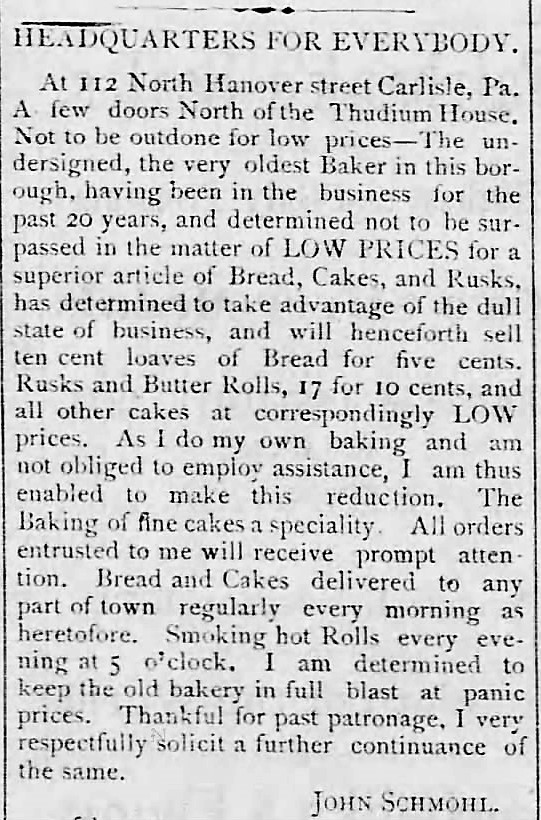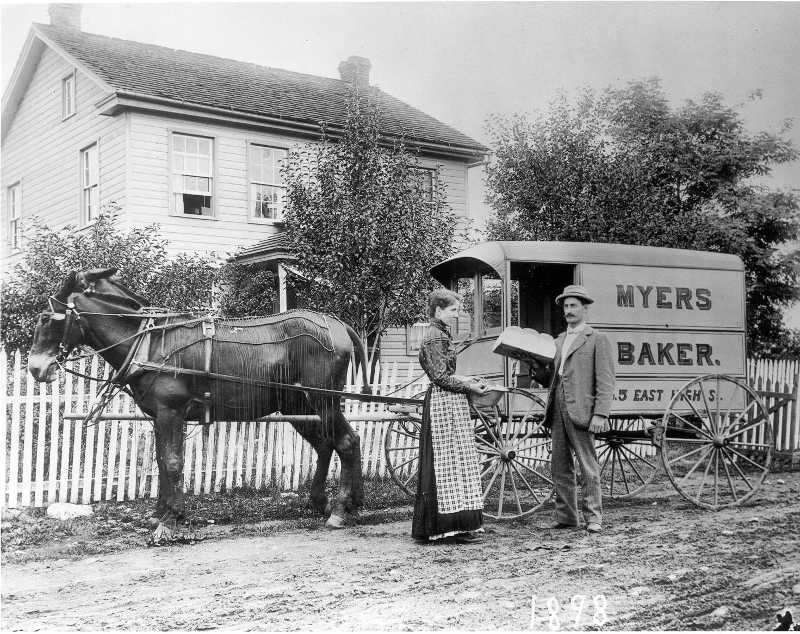The 1861 “List of Retailers” in Carlisle included five bakers. At least three of them were German immigrants who had settled in Carlisle in the 1830s and 1840s; John Sellers, John Schmohl and George Grossman.
Of the three men listed as bakers in 1861, Grossman had the largest business. The 1860 U. S. Census recorded that two young men from Hesse-Darmstadt, 19-year-old baker Frederick Cramer and 17-year-old baker’s apprentice Lewis Englebach were living in Grossman’s household, and his real estate was worth $8,000. John Sellars had $6000 worth of real estate and Schmohl had $2700. Neither Schmohl nor Sellers had baker’s assistants or apprentices living in their households.
John Sellers was the first of the three to settle in Carlisle. Sellers was born Johann Sillers in Wurttemberg, Germany in 1793. He moved to Carlisle in the 1830s and was naturalized in April 1842.1
Sellers bakery was located on the corner of Bedford and Louther streets. An old timer recalled that John Sellers “was the man that first sold sugar rings with a hole in the middle. In those days,” he wrote, “the bread was peddled in a big market basket, and a little bugle was used to notify the customers.”2
John Schmohl was born in Wurttemberg, Germany in 1825 and came to America in 1845. He was naturalized in Carlisle in 1851.3
Schmohl’s bakery was located first on South Hanover street and then at 112 North Hanover Street, a few doors north of Thudium’s Hotel. He advertised that “his bread is of the best quality, while his butter rolls, which can be obtained smoking hot every afternoon at five o’clock, have become very popular and are in great demand evidenced by the crowds of persons who visit his bakery daily in quest of them”4
Schmohl’s business was booming in the spring of 1874. He told the editor of the newspaper that he was “in the height of the roll season. He sold 500 to a single family up town the other evening.” The editor printed a bit of “doggerel” that he had often heard.
Mr. Brown is the best baker in town,
Mr. Sellers beat all the other fellows,
While John Schmohl surpasses them all.5
In a very detailed advertisement in 1875, Schmohl said that he was the oldest baker in Carlisle and had been in business for the past 20 years. The country was in the grip of the Depression of 1873-1879, and because business was dull, Schmohl was determined to sell his baked goods at the lowest prices. Since he didn’t have to employ help, and he did all his own baking, he was able to reduce the cost of his goods. He was determined “to keep the old bakery in full blast at panic prices.”
Business picked up, and in 1877 Schmohl got a new horse and harness for his wagon as well as a musical set of bells to announce his approach to customers.6 Although still in the bakery business, and for whatever reason, during the summer of 1884 Schmohl raised more than 60 canaries in his house. In November, he advertised that they had developed into fine singers and could be purchased from him at reasonable prices.7
In 1885, Schmohl offered to sell or rent his property which contained a large three-story back building, a complete bakery, ware room and other out buildings on a 30’ x 240’ lot.8 In 1892 he closed his business and sold the fixtures from his shop which included platform scales, two French plate show cases, four dozen candy jars, counters and shelves.9 Having retired from the business due to ill health, he died in 1904 at the age of 79.
George Grossman was born in Hesse-Darmstadt in 1821. He was naturalized in Carlisle in August 1853,10 and in 1854 he purchased Jacob Sener’s property on North Hanover Street. During the next few months he made “extensive arrangements to his baking apartment with the view of accommodating the increased demand for Domestic Bread.” He advertised that he baked fresh bread and rolls daily and kept a variety of cakes on hand.11
Grossman “was the very first baker in town to introduce a bread wagon. He baked the best sugar rings. His establishment was first located in the alley opposite the old market house. He subsequently moved to the east side of North Hanover Street between Louther and High.” 12
Grossman suspended his bakery business briefly in 1862 when his wife developed a case of varioloid. Smallpox was frightening, and varioloid was a weak form of it. In April 1862, Grossman advertised that he was reopening his bakery, and he hoped the public would resume their patronage of his shop. A statement from Dr. S. B. Kieffer said that Grossman’s wife had a mild attack and was “entirely recovered.” He assured the public that there was no chance of transmitting the disease through the bakery.13 It’s likely that Grossman’s business did not recover because he moved to Baltimore shortly thereafter.


